Most well-known for its breathtaking countryside and its seemingly endless rolling hills of central Italy, the region of Tuscany is one of the most-visited places in the country. But were in Tuscany should you stay? To help you decide, we’ve come up with a list of the best towns to stay in and visit in Tuscany.
From its capital city of Florence to a few of the much smaller towns out in the countryside, we’ve combed through all the different options and come up with the most beautiful towns in Tuscany that you just can’t miss. From exploring ancient structures, seeing priceless artwork, and enjoying some of the best views in all of Italy, Tuscany is the place to be.
So without further adieu, let’s get into the list. Here are the 6 best towns to stay in Tuscany and a bit about what you can do in each.
Florence
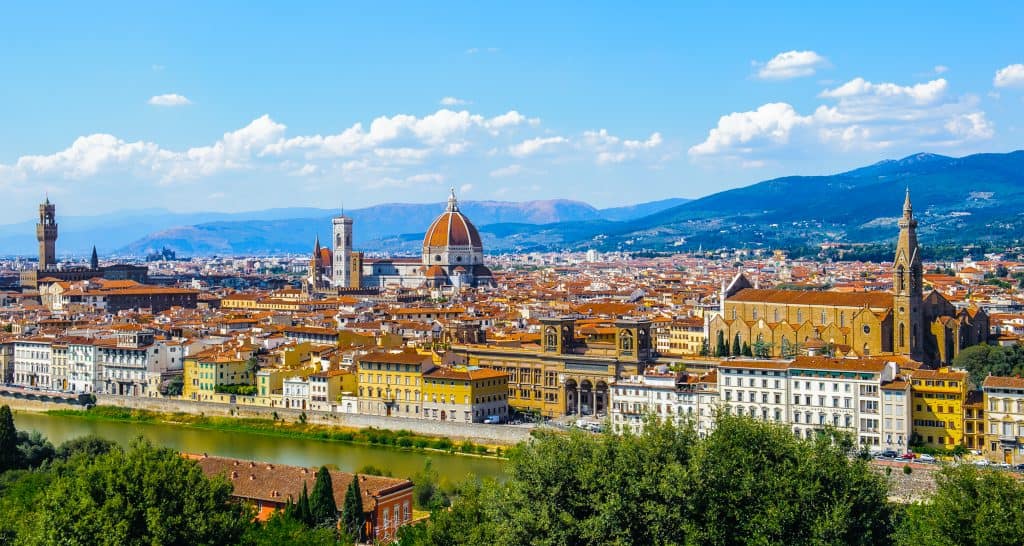
As the capital city of the region of Tuscany, it should come as no surprise that Florence makes the list of the best places to stay. As one of the busiest and one of the most beautiful cities in Tuscany, Florence has it all. From art galleries to historic religious buildings to some of the best food in the region, you can’t go wrong by visiting Florence. Not only that, there are some of the widest range of variety of accommodations in Florence.
Uffizi Gallery
Situated on the banks of the Arno River, the Uffizi Gallery is one of the best art collections in all of Italy, housing artifacts from the Middle Ages through modernity. The Uffizi Gallery is often described as Italy’s first modern museum. At the same time, it is rich with history as it was originally curated by the famous Medici family in the 16th century.
The museum is home to works by some of Italy’s most famous artists, including Botticelli, Raphael, Titian, and more. It’s perfect for art lovers or anyone who appreciates history. A visit to the Uffizi Gallery is a great way to spend an afternoon in Tuscany’s capital city.
Giardino Bardini
Although it isn’t the most popular set of gardens among tourists — that title belongs to the Boboli Gardens — the Giardino Bardini is the locals’ top choice. And if the locals are choosing something that’s seemingly far less popular than what the tourists are choosing, you can usually enjoy a much better experience trusting the locals!
And when it comes to enjoying the gardens of Florence, the locals are spot on. Spend your day exploring the gardens as you walk through a rolling olive grove, the purple wisteria arch, or up the famous pergola-covered staircase. No matter how you choose to spend your time in these gardens, it’ll be worth the visit.
Piazzale Michelangelo
Arguably the most popular public square in Florence, even though it isn’t in the city center like they usually are, is without a doubt Piazzale Michelangelo. The famous public square is located outside the city center and up on top of a nearby hill, offering visitors views of Florence, unlike anything you can find anywhere else.
The Piazzale Michelangelo is plumb full of vendors and cafes all around it, so it’s the perfect place to grab a snack or a coffee and watch the culture of Florence all around. Don’t forget to check out the square’s main attraction — the replica of Michelangelo’s famous David statue. Which just adds to the ambiance of the plaza and enhances the entire experience.
Ponte Vecchio
One of the most famous bridges in all of Tuscany, the Ponte Vecchio of Florence is a well-known social center of the city, which used to be ripe with artisans making their livings. The structure standing today is not the original one that stood in its place. The original bridge was destroyed by a massive flood in the 1300s, taking with it the livelihoods of many individuals.
Even though the original was destroyed over half a millennium ago, the new Ponte Vecchio built in its place still acts as a major hub of Florence. The bridge is entirely covered, and there are windows all over and many open-air archways, making it a true architectural masterpiece.
Siena
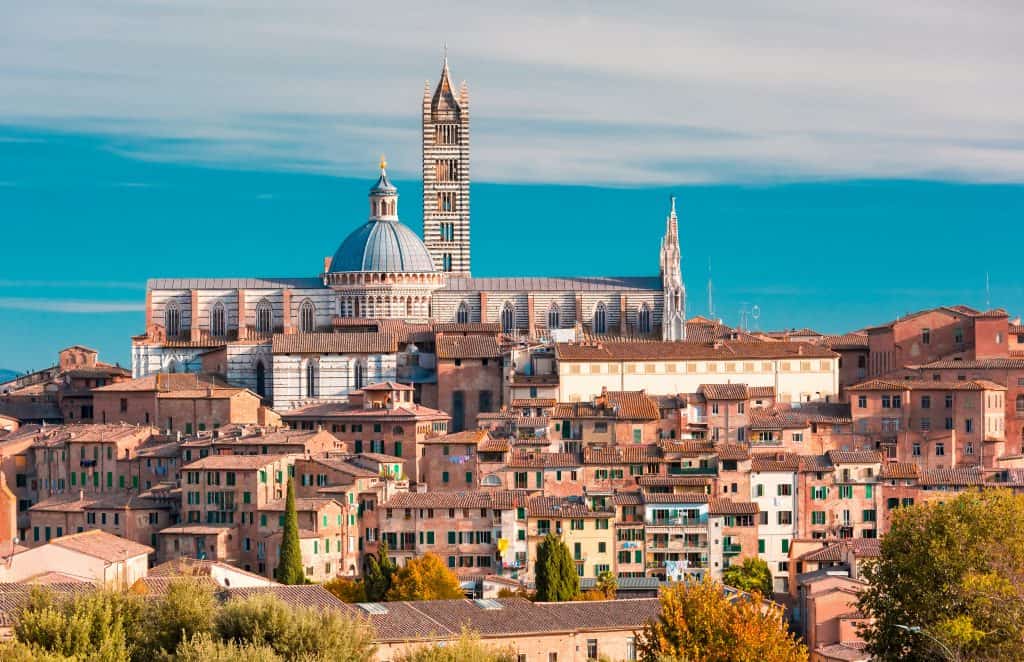
For an option far less known worldwide than Florence, Siena is one of the best Tuscan towns that relatively few people know about. The small city (less than 50 square miles total) is best known for its medieval structures and buildings. So if you’re into historic buildings and exploring, then Siena should be at the top of your list.
Piazza del Campo
One of the most intriguing public squares in Tuscany, the Piazza del Campo was designed and constructed in a shell-shaped rather than the typical square. But that isn’t the only design aspect that was chosen very deliberately. The floor is easily divided up into nine different sections, paying homage to “The Nine” who ruled over the town of Siena during its heyday in medieval Europe.
The social center of Siena, the Piazza del Campo, was designed as a place for vendors, merchants, shoppers, and visitors to have a place to go and mingle with one another. From the Piazza del Campo, you’ll be able to head to any of the other great attractions in Siena you find on this list.
Palio di Siena
If you’re in the mood for something far different than anything else on this list, consider checking out the Palio di Siena — which is a horse race around the Piazza del Campo. Only offered twice a year (during July and August), this event is only for those who are visiting Siena during the peak travel season.
But if you do happen to be in town during the event, you’ll want to check it out. The race itself is over quickly with just three laps around the public square, but the buildup and the hype throughout Siena surrounding the event are palpable. Between the vendors and the crowds, it’s something unique that Siena has to offer.
Fonte Gaia
Although Siena is home to many beautiful fountains that could have easily made it onto this list, Fonte Gaia is our favorite one. Built in the early 15th century, Fonte Gaia uses an underground piping system to bring water to itself from roughly ten miles away. And when you think about that in terms of 15th-century technology, it’s truly an incredible feat of engineering.
The beautiful fountain was initially built with an ornate frame constructed around it hundreds of years ago. In the years since marble has replaced the original, but that isn’t necessarily a bad thing — the marble frame surrounding the piercing blue waters makes the Fonte Gaia something that you have to check out.
Lucca
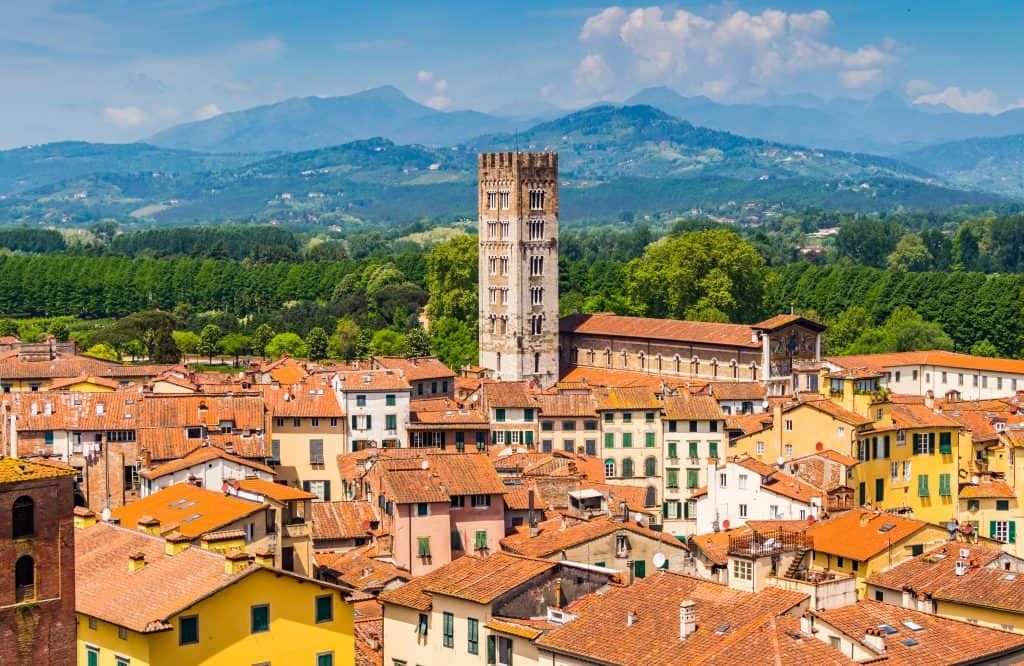
Located along the Serchio river, Lucca is another one of Tuscany’s lesser-known towns. But Lucca truly is a hidden gem of the region. Most recognized for its tree-lined walkways, city walls, wineries to tour, and cobblestones streets, Lucca is one of the most beautiful towns in Tuscany. If you have the chance to visit here, you don’t want to miss it.
Walk the City Walls
If you’re going to pick one thing to do in Lucca, it has to be walking the city walls. And when we say that, we don’t just mean walking around them in admiration. We mean actually walking along the top of the city walls! It’s a surreal experience and something you don’t want to miss.
The city walls surrounding Lucca are one of the best-preserved fortifications anywhere in Italy, much less Tuscany. The walls were constructed during the Renaissance and still stand strong to this day. With a grass-covered footpath along the top from bastion to bastion, walking the walls is easy to do and will be one of the most unique things you’ll do in Tuscany.
Lucca Cathedral
Lucca’s most well-known structure is its impressive cathedral, the Lucca Cathedral. As you walk up towards the stunning cathedral you’ll likely notice two things about its exterior — the incredible facade of the cathedral itself and the half-unfinished bell tower next to it.
Interestingly, the bell tower is only half-finished, with the bottom being exposed brick and the top half the ornate white finish of the rest of the area. The incredible archways that dominate the front of the church are some of the prettiest construction features you’ll find in Lucca. This 11th-century cathedral is a total must-see while you’re in the area.
Piazza Napoleone
Although not the main public space of Lucca, Piazza Napoleone is arguably the most interesting one to visit. Situated near the center of the city, Piazza Napoleone is typically bustling with people — both locals and visitors alike — going about their everyday life and showcasing the Tuscan culture that you’re bound to fall in love with.
The Piazza Napoleone is known for being host to many important structures and buildings worth visiting. Around the square, you’ll find places including the Ducale Palace, the Giglio Theatre, the Museo del Risorgimento, and more. It’s a place rich with culture and history and is a great way to spend a day.
Aqueduct of Nottolini
If you’re up for something a little different and want to see one of the most incredible feats of architecture and construction that Lucca has to offer, then you should take the short journey to check out the Aqueduct of Nottolini. It is located just a short way south of Lucca (about 1.5 miles to its start), so it won’t take too long to get there.
And once you do get there, it’s a sight worth seeing. Stretching for over 1.5 miles with its arched stone construction (containing over 400 arches!), this aqueduct is an engineering and architectural marvel. Designed to carry water from the mountains to Lucca hundreds of years ago, the structure remains in its entirety.
Pisa
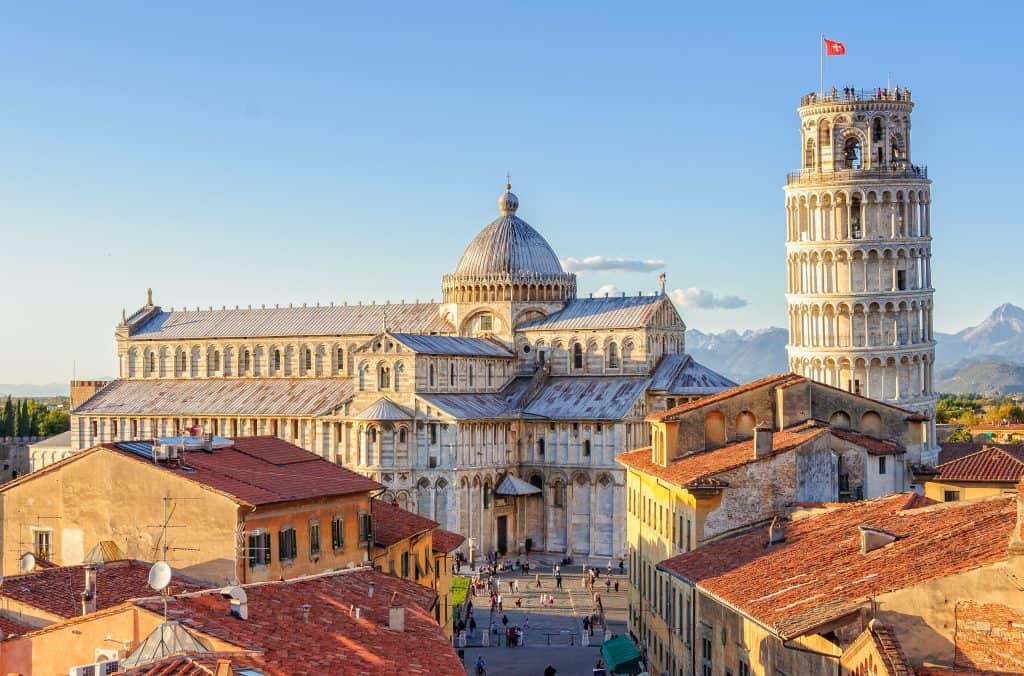
Coming in just behind Florence as the second most popular city on this list, Pisa should make it into everyone’s shortlist of where they want to stay while in Tuscany. It is home to one of Italy’s most famous landmarks not in Rome, the Leaning Tower of Pisa, but there is also much more to this city. Don’t get caught up on just the famous bell tower. Come see Pisa for what it truly is — one of the best cities in Tuscany.
Leaning Tower of Pisa
Without a doubt, the most famous structure in Pisa — if not all of Tuscany, the Leaning Tower of Pisa is by far the biggest reason that people visit Pisa. Built long ago in the 12th century, the famous bell tower was constructed as a supplement to the nearby cathedral. But soon after construction, its poor foundations were realized as the structure began to lean.
Even after 800 years of leaning, this well-known landmark continues to noticeably lean to this day, which is one of the big reasons that it’s become so famous. You can climb to the top of the tower and get unobstructed views of the city, and the building itself is impressive. If it’s your first time visiting and touring Pisa, it’s just one of those things that you have to do on.
Campo Santo
Located relatively close to the Leaning Tower of Pisa, the Campo Santo (Holy Field, in English) is another building complex that is worth checking out during your visit. The entire structure is built of impressive stone, and the amount of craftsmanship that’s gone into the building is fascinating.
But the main draw of the Campo Santo is the enormous courtyard in its center. The beautiful green lawn is adorned with flowers and surrounded by the incredible stone archways that make up the walkways around it. The central section of the complex offers visitors some of the best photo ops in the region.
Palazzo dei Cavalieri
The main attraction of the famous Knights Square in Pisa is the palace overlooking the public area, the Palazzo dei Cavalieri. The imposing, rectangular-shaped palace stands tall above the square with its yellow facade and massive central staircase taking visitors up to the main entrance.
One of the most well-known palaces in Pisa, the Palazzo dei Cavalieri was built in the 16th century as the headquarters for the historic Knights of St. Stephen. Between the architecture, the stonework, and the beautiful interior, this palace is an absolute must-visit while you’re in Pisa.
Borgo Stretto
If you’re a shopper at heart and want to experience authentic Italian luxury brands in Tuscany, Pisa is one of the best places to be. And if you’re in Pisa, there’s no better place to go than the Borgo Stretto. This archetypical Tuscan street is located in the social center of Pisa, starting at the Piazza Garibaldi.
The sides of the Borgo Stretto are lined with shops, boutiques, designer stores, and a plethora of cafes. So it’s the perfect place to go and grab a coffee while you shop till you drop. As a bonus of the area, all the buildings here are impressive examples of classic Italian architecture that will catch your eye.
Stroll Along the River Arno
As one of Italy’s main waterways (only surpassed by the Tiber), the River Arno is the most prominent river in Tuscany. It runs 150 miles through central Italy from Mount Falterona down through the Tyrrhenian Sea. Pisa was built along its banks due to its importance in the region.
The section of the river that runs through Pisa offers visitors lush landscapes and great photo ops combined with the peaceful sounds of the flowing water. Sitting down on a bench on the shore or walking along the banks with that special someone is one of the best ways to spend a quiet evening in Pisa. Pure serenity.
Volterra
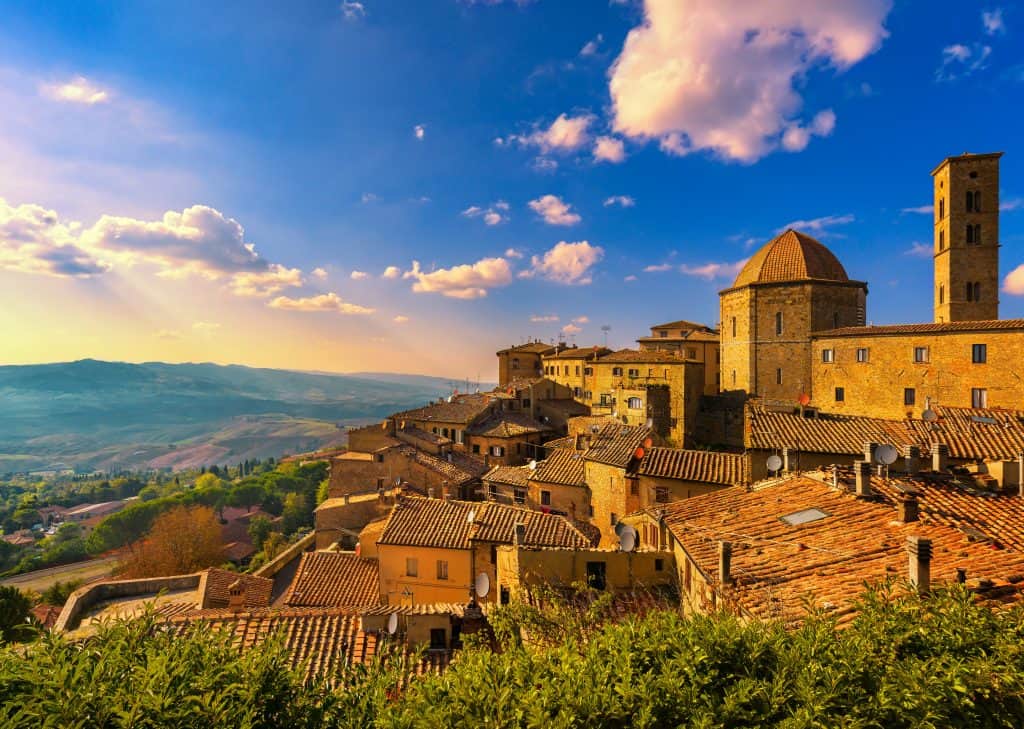
With a population of just over 10,000 people, Volterra is another one of Tuscany’s hidden gems. But it’s also one of the best places in Tuscany to explore and check out some of the best ancient structures in the area. Volterra is perfect for wandering around and just looking at everything, and it’s home to one of the coolest outdoor theaters you’ll find anywhere in the world.
Piazza dei Priori
The main public square of Volterra and the social hub of the town, Piazza dei Priori, is the best place to go to start your visit. The square is typically bustling with visitors and locals alike and is home to some of the most interesting buildings in town. One of the premier structures you’ll find here is Palazzo dei Priori, which is now the city’s Town Hall — the oldest in all of Tuscany.
On the opposite side of the square, you’ll find Palazzo Pretorio and the astounding tower of Torre del Podesta. If you look close enough on the top of the tower, you’ll find a statue affectionately known as Porcellino to the locals (translating to Piglet). Besides the impressive structures, you’ll also find many restaurants, shops, and cafes for you to explore and enjoy. You can visit the square on your own or join a walking tour.
Teatro Romano
Walk through the popular gate of the town walls, Porta San Francesco, and you’ll see an incredible structure in the distance. A Roman theater dating all the way back to the first century stands tall among the excavated earth around it.
With excavations starting in the mid-1900s, this ancient structure’s stage was revealed. Along with the stage, 19 tiers of seating had been carved into the hills by the Ancient Romans so they could attend the shows and plays that the theater was built for. It’s a stunning place that will take you back in history just looking at it.
Medici Fortress
One of the most iconic landmarks of Volterra, the Medici Fortress dominates the skyline with its prominent hilltop location overlooking the rest of the city. This fortress was constructed for two reasons — to protect the city from invaders, of course, but also to protect the Medici from the citizens below that they thought might revolt.
The fortress’s original foundation was constructed in the mid-1300s as a standard Rocca to offer fortifications for the city. But the newer sections were added on later in the late 1400s, making it into the imposing structure that it is today. This fortress, rich with history, has been turned into a modern prison. Therefore it is not open to the public on the inside, but the outside and the surrounding areas can be admired.
Parco Archeologico
Excavations beginning in the early 1900s outside the city limits of Volterra have revealed an ancient building complex dating back to the 2nd century BC, located near the Medici Fortress. This complex, now able to be visited by the public, is known as Parco Archeological — the Archeology Park.
A slew of infrastructure was found for this complex through the excavations, including two temple-like buildings, an ancient plumbing system, a pool, and a cistern. The structures here show Etruscan, Roman, and medieval construction traits, making them some of the most diverse and interesting structures in the area.
San Gimignano
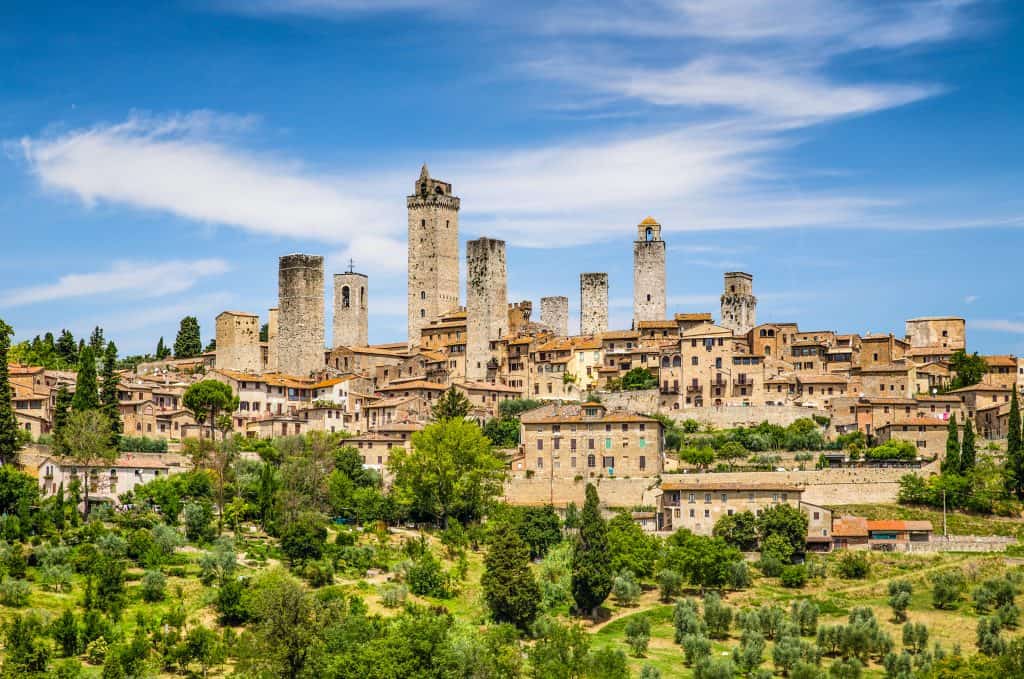
Last but certainly not least, we have another one of Tuscany’s smaller towns, San Gimignano. This city’s peculiarity starts with the triangular-shaped public “square” at its center, which is then surrounded by the towers that make San Gimignano well known. But it’s intrigue doesn’t stop there. It’s just one of those places you have to visit, and you’ll be glad that you did.
Centro Storico
The Centro Storico of San Gimignano is the place to start your visit to this Tuscan town. The principal public gathering place of San Gimignano is located in this city center, the triangular Piazza della Cisterna. This public area is full of visitors and locals alike, as well as the home of many different towers for you to climb and explore.
Piazza Duomo is also housed within Centro Storico’s reaches, so you can start to get an idea of just how big it is. With all the different towers, churches, and buildings surrounding Centro Storico, it’s an absolute must-visit for any architecture fans out there. And from the city center, you can head out to do any of the below activities in San Gimignano.
Rocca Remains
At the top of the tallest till along San Gimignano’s city walls sits the ruins of a castle (Rocca) that once stood in their place. Back in its heyday, this fortress stood tall amongst the rest of the walls and was a symbol of strength for the town, but these days just the ruins are left.
Originally constructed back in 1353 by the Florentines, its demolition was ordered just two centuries later, in 1555 by Cosimo I. Only the ruins of the tower and surrounding structure remain, but you can still go to the top to catch some of the best views around.
Sant’Agostino Church
While you’re in San Gimignano, you should consider visiting Sant’Agostino Church. When you walk up to it from the exterior, you might be thinking, why on earth would you want to visit this of all places? After all, the outside just looks like a standard plain brick building.
But go inside and take a look around, and you’ll quickly realize why it’s worth visiting. Inside you’ll find lavish decorations and breathtaking design. A beautiful marble altar (which contains the remains of San Bartolo) is the centerpiece. But the walls throughout are adorned in incredible artwork no matter where you look.
San Gimignano 1300
Any history buffs or anyone into art and historical artifacts should check out San Gimignano 1300 while in town. While there is plenty to see while in the museum, the standout piece is an incredibly intricate scale model of what San Gimignano was like in 1300.
Other than the amazing scale model of the city, you can find lots of other miniature scenes and scale models depicting what life was like in San Gimignano over the centuries. The detailed exhibits are some of the most well-done anywhere in the world, and the museum is well worth a visit.
Explore the City Walls
The perfect complement to the Centro Storico above is walking along the impressive city center walls. The pathways around the walls are plush with benches to rest on, exclusive views of the walls, and a few different historical gates worth checking out.
The gates to which you should pay attention include Porta San Giovanni, Porta San Matteo, and Porta delle Fonti. All three gates were constructed between the 12th and 13th centuries and offer visitors a look into the past as you peer through these ancient structures.
Related Resources

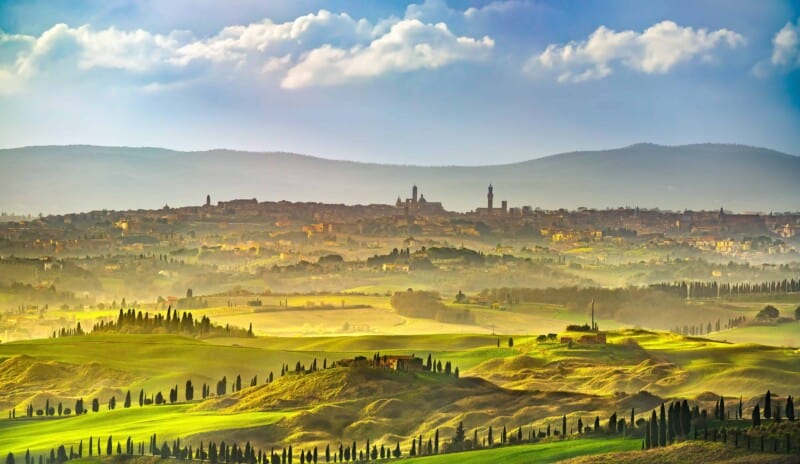
0 Comment